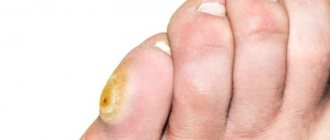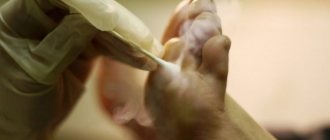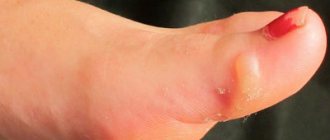How does a water callus form?
A callus forms where excess pressure and friction are applied to the skin.
The most common reason that leads to the formation of calluses is wearing tight or ill-fitting shoes. A water callus is accompanied by the appearance of a blister that is filled with fluid. The mechanism of its formation is simple. When friction is applied to the skin and soft tissues, they begin to separate. The top layer of the epidermis comes off first. Exudate begins to flow into the resulting space. It consists of blood, intercellular fluid, and plasma. Leukocytes contained in the blood destroy all pathogenic flora and prevent microbes from multiplying. The plasma, in turn, prevents further erasure of the dermis.
Water blisters hurt, cause a person to experience discomfort, and worsen their quality of life. To prevent infection from getting into the callus, it is necessary to begin treatment as early as possible.
Causes and symptoms of wet callus formation
A wet callus occurs due to friction and shearing of the upper layers of the skin relative to the deeper ones. As a rule, initial pathological changes in the structure of the integument remain asymptomatic. Prolonged mechanical action leads to peeling of part of the epidermis, an inflammatory process and the formation of a blister filled with liquid.
The immediate causes of a watery callus can be:
- hard or too tight shoes, wearing them on bare feet,
- abrasion of the skin when in contact with hard wardrobe items or accessories (for example, a bag belt),
- long-term work with gardening and repair tools,
- playing sports with hard equipment (playing tennis or cycling).
Sensitive and thin skin, hyperhidrosis and sweating of the feet when wearing warm shoes or in the summer significantly increase the risk of developing a wet blister.
The main symptoms of water callus on the leg:
- pain;
- affected skin;
- filling the affected area with liquid;
- pain when pressing on the area;
- pain during the formation of the callus and after its opening;
- discomfort when walking.
What causes it?
According to the classification, calluses are divided into hard (dry) and soft.
Dry calluses (corns) are formed due to the accumulation of a large number of keratinized cells in a limited area of the skin, with the formation of a core that goes to a fairly large depth.
Among the causes of dry calluses, experts mention a high degree of obesity and an addiction to wearing high-heeled shoes.
The heavy weight and unnatural position of the leg increase the pressure on the skin, which reacts to injury by forming a callus.
If a callus has appeared on the toe, inflammation usually occurs if a person attempts to remove the callus on his own using a pumice stone, a pedicure grater or scissors. Usually, along with the keratinized area, the healthy part of the skin is treated, and the resulting cracks or wounds become infected.
The same consequences are associated with the use of products for calluses and preparations containing salicylic acid. The aggressive composition has a strong effect on healthy skin , which leads to inflammatory phenomena.
Wet calluses are divided into watery, bloody and purulent. First on the list are blisters filled with liquid, popularly called “dropsy.” Such damage is easy to get rid of, so infection of dropsy is extremely rare.
It is more difficult to cope with bloody and purulent calluses. Bloody formations appear in the area where blood vessels are located, resulting in blood instead of clear liquid inside the bladder. The treatment is long-term, accompanied by a number of precautions necessary to prevent accidental opening and infection of the wound.
A purulent callus requires immediate action, since pus always indicates an infection has occurred . Purulent formations pose a serious danger to the body; they are treated over a long period of time using a number of medications.
The main signs by which you can independently determine that the callus on your toe is inflamed are:
- changes in the transparency of the liquid inside the blister;
- noticeable inclusions of yellow or gray pus;
- the presence of sharp pain in the area of formation without direct contact;
- expansion of the reddened area of skin surrounding the callus;
- changes in the appearance of the damaged area, expressed in the form of swelling and swelling;
- increase in body temperature.
Let's find out what to do if the callus on your finger becomes inflamed:
- change shoes to more comfortable ones;
- do not open the bubble yourself;
- do not use questionable drugs without a doctor’s prescription;
- do not try to remove the keratinized part using a sharp knife, scissors, pumice stone or pedicure graters.
At the first sign of a callus, consult a dermatologist . The specialist will determine a way to eliminate the problem that will prevent infection and further development of the inflammatory process.
Diagnosis of water callus
Water calluses on the feet are diagnosed as follows:
- an examination is carried out by a dermatologist;
- You may need additional consultation with a rheumatologist, podologist or orthopedist.
Calluses should not be confused, for example, with inflammatory changes in joints, pinched nerves, inflammation of hangnails, genetically determined keratinization of the skin, and warts.
When diagnosing water callus, it is important to determine whether the patient has concomitant diseases. For example, varicose veins, diabetes mellitus, venous insufficiency, neuritis and so on.
Useful video
Recommendations on how to choose the right ballpoint pen:
A callus on the finger from a pen is a temporary defect that can be gotten rid of with a little effort. To do this, it is absolutely not necessary to see a doctor. You should follow basic preventive measures or use home recipes that will put your hands in order.
If you find an error or traces of code (for example, individual characters >, ],=...), please select a piece of text and press Ctrl+Enter.
Is it possible to pierce a callus with liquid?
The blood plasma filling the bladder protects the injury site from pain. Therefore, small calluses usually heal on their own and do not need piercing. To do this, simply cover the problem area with a band-aid.
If the formation is large in diameter and causes significant discomfort, it can be pierced. Otherwise, the protruding callus may burst on its own as a result of injury. After a puncture, healing proceeds faster than with an accidental rupture.
To avoid infection and ensure rapid healing, you must follow a number of rules:
- Before piercing, treat damaged skin and hands with an antiseptic solution.
- Use a sterile needle. To disinfect, you can hold it over a fire or put it in alcohol for a few minutes.
- Make punctures on the sides of the callus, holding the needle parallel to the skin.
- If the callus is large, pierce it in several places to completely release the liquid.
- Use gentle movements to get rid of the liquid inside.
- It is better to pierce the first day after the formation of a blister.
- After the puncture, do not remove the covering skin under any circumstances; as it dries, it will come off on its own.
What is the danger of a callus on the thumb?
When calluses form, nothing destroys a person’s life, but there is a high risk of infection if the callus is in the form of dropsy.
As a result of damage to the bladder, a wound is formed and, if measures are not taken to prevent the penetration of pathogenic microflora into it, infection can occur.
The formation of growths often prevents a person from walking normally.
When the foot is compressed by shoes, pain appears.
The presence of corns and fresh calluses provoke a burning sensation and pain when walking.
Treatment of such growths should begin immediately after they appear.
Treatment of water callus
Small water calluses heal on their own. But in some cases, aching pain occurs, the liquid takes on an opaque cloudy appearance and the skin around the wound becomes inflamed. This indicates infection of education. It is strictly forbidden to self-medicate; you need to urgently go to the clinic.
If there are no signs of inflammation, then you can speed up the healing process using medications.
The following ointments are suitable for treating wet calluses:
- Levomekol – combines antiseptic and healing properties. The wet callus is sealed with a plaster or covered with a sterile bandage. It is necessary to change at least 3 times a day.
- Salicylic ointment – anesthetizes, relieves inflammation and disinfects. The product is left overnight, and in the morning the leg should be rinsed thoroughly.
- Compeed patch for wet calluses is impregnated with a special composition that disinfects and dries the blister.
Apply the product in a thick layer onto a sterile bandage and apply to the painful area. It is better to apply bandages at night.
For quick healing of formations, it is better to use Compeed patches for wet calluses with hydrocolloid properties. They are made using special technology from breathable fabric. The patches protect the wound from infection, accelerate the skin regeneration process and provide pain relief.
What is prohibited to do
When a growth appears, it is strictly forbidden to pierce it yourself. This is explained by the fact that it is possible to introduce an infection into the wound, which will negatively affect the treatment process.
Treatment of a burst callus
If the neoplasm has burst, then it is recommended to clean it of contamination. For this purpose, the wound is washed in warm water and soap.
If there is dirt under the skin, it is recommended to remove it without fail.
Next, the wound is treated with an antiseptic solution, which should not contain alcohol. After this, medicine and a sterile bandage are applied to the wound.
First aid
When a growth appears, patients often experience severe pain. In this case, he is recommended to provide first aid. The patient should get rid of tight shoes.
How to treat a wet callus, watch this video:
If this cannot be done, then it is recommended to apply a sterile bandage or plaster to the site of the growth.
Traditional methods of treatment
To speed up the process of skin restoration, you can supplement traditional methods of treating calluses with folk remedies.
The most effective of them are:
- Applying a compress with aloe pulp to the callus. This procedure will reduce the intensity of pain, eliminate swelling, and relieve inflammation. To prepare a compress, you need to remove the skin from the aloe leaf. In this form, the plant is applied to the affected area. The sheet must be secured with a bandage or adhesive tape. The application should be changed once a day. Treatment continues until the skin is completely restored.
- Treatment of calluses with a mixture of vegetable oil and tea tree oil. In this case, take one part tea tree oil to 3 parts vegetable oil. Apply the composition to the callus 4 times a day. This allows not only to speed up tissue regeneration, but also to disinfect the wound. The concentration of substances must be observed, since tea tree oil can cause skin burns if applied to the dermis in its pure form.
- Compress with herbal decoction. To treat calluses, you can use a decoction of chamomile or calendula. When the product is ready, soak a bandage with it and apply it to the callus. This will speed up the recovery process and relieve inflammation.
- Performing baths with a decoction of oak bark. Such procedures make it possible to dry the callus, reduce inflammation, and speed up recovery. The bath should be done once a day, for 5-10 minutes. After treatment, the feet need to be dried.
Prevention of water blisters
There are several recommendations that will help prevent the appearance of vesicular calluses. To prevent a wet callus from forming on the skin, do the following:
- Pick up new shoes after lunch;
- Use silicone pads to prevent the hard fabric of your shoes from chafing;
- Wear socks only made from natural fabric;
- Shoes must be dried after walking and playing sports, especially in the summer;
- Use special anti-sweating products;
- Several times a week, perform foot baths with natural ingredients: chamomile, calendula, oak bark.
- Massage your feet regularly with a moisturizing cream or oil that can soften the skin of your feet.
To prevent the formation of wet calluses on your hands, you should wear special protective gloves when working in the garden, doing repairs and playing sports.










